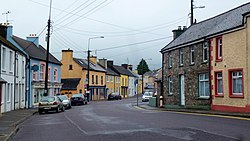Drimoleague
| Drimoleague Irish: Droim Dhá Liag | |
| County Cork | |
|---|---|
 Main Street | |
| Location | |
| Grid reference: | W129461 |
| Location: | 51°39’35"N, 9°15’39"W |
| Data | |
| Population: | 451 (2016) |
| Local Government | |
Drimoleague (historically Drumdalege, is a village in the west of County Cork, found along the R586 road at its junction with the R593, roughly halfway between the towns of Dunmanway and Bantry. It is within the parish of Dromdaleague.
This is a village of some 450 people. It has a range of local shops, four public houses, a local GAA club and pitch as well as a number of tourist attractions.
The name of the village is from the Irish Droim Dhá Liag, meaning 'Ridge of two stones'.[1]
History
Drimoleague village was founded in and around 1851 in the townland of Baurnahulla, after Drimoleague railway station was built on the Cork, Bandon and South Coast Railway line. Situated in West Cork, Drimoleague is home to In 1956 a new Roman Catholic Church was completed, designed by Frank Murphy . It is credited as West Cork's first building in the modernist style.[2]
Clodagh Standing Stones, a Stone Age site, sand three miles to the north-east.
Drimoleague is the start for one of the five Pilgrim Paths of Ireland, St. Finbar's Pilgrim Path, which ends twenty-two miles away in Gougane Barra.[3]
Pictures
-
Former railway station that led to the foundation of Drimoleague
-
Drimoleague station in 1955
References
- ↑ Drimoleague: Placenames Database of Ireland
- ↑ English, Conor (21 July 2018). "Cork architect the unsung hero of modernism". Irish Examiner. https://www.irishexaminer.com/property/homeandoutdoors/arid-30856730.html.
- ↑ "St Finbarr’s Pilgrim Path, Cork". Pilgrim Paths of Ireland. https://www.pilgrimpath.ie/pilgrim-paths-day/st-finbarrs-pilgrim-path-cork/. "In West Cork and South Kerry the practice of walking pilgrim paths to St Finbarr’s hermitage in Gougane Barra has been in place for many centuries. One such path leads from Drimoleague, where – local tradition has it – St Finbarr arrived at the Top of the Rock in the sixth century and admonished the people to return to Christ, before making his way to Gougane Barra."

